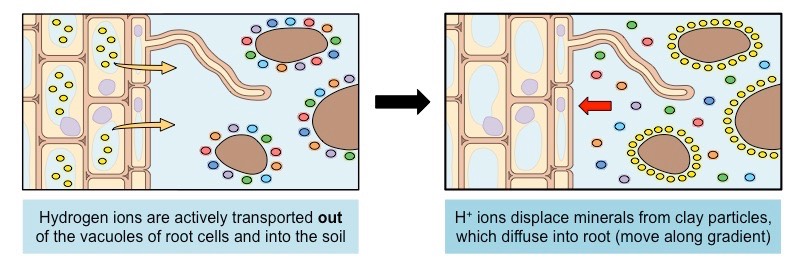![]()
Understanding:
• Active uptake of mineral ions in the roots causes absorption of water by osmosis
Plants take up water and mineral ions from the soil via their roots and thus need a maximal surface area to optimise this uptake
- Some plants have a fibrous, highly branching root system which increases the surface area available for absorption
- Other plants have a main tap root with lateral branches, which can penetrate the soil to access deeper reservoirs of water
The epidermis of roots may have cellular extensions called root hairs, which further increases the surface area for absorption
- Materials absorbed by the root epidermis diffuse across the cortex towards a central stele, where the xylem is located
- The stele is surrounded by an endodermis layer that is impermeable to the passive flow of water and ions (Casparian strip)
- Water and minerals are pumped across this barrier by specialised cells, allowing the rate of uptake to be controlled
Structure of a Root (Vascular Plant)

Mineral Uptake
Fertile soil typically contains negatively charged clay particles to which positively charged mineral ions (cations) may attach
- Minerals that need to be taken up from the soil include Mg2+ (for chlorophyll), nitrates (for amino acids), Na+, K+ and PO43–
Mineral ions may passively diffuse into the roots, but will more commonly be actively uploaded by indirect active transport
- Root cells contain proton pumps that actively expel H+ ions (stored in the vacuole of root cells) into the surrounding soil
- The H+ ions displace the positively charged mineral ions from the clay, allowing them to diffuse into the root along a gradient
- Negatively charged mineral ions (anions) may bind to the H+ ions and be reabsorbed along with the proton
Uptake of Mineral Ions via Indirect Active Transport

Water Uptake
Water will follow the mineral ions into the root via osmosis – moving towards the region with a higher solute concentration
- The rate of water uptake will be regulated by specialised water channels (aquaporins) on the root cell membrane
Once inside the root, water will move towards the xylem either via the cytoplasm (symplastic) or via the cell wall (apoplastic)
- In the symplastic pathway, water moves continuously through the cytoplasm of cells (connected via plasmodesmata)
- In the apoplastic pathway, water cannot cross the Casparian strip and is transferred to the cytoplasm of the endodermis
Apoplastic vs Symplastic Pathway

